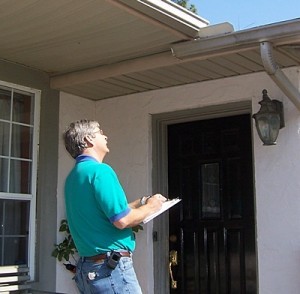Attending an open for inspection can be a daunting task for anyone, no matter hoe experienced you are.
Remember to look at the building itself as much as you look at the things like the layout of the kitchen and whether or not there’s an en-suite. If you’re serious about buying the property it pays to be thorough and a few simple maintenance checks can sometimes make the difference between buying your dream house and stepping into a costly nightmare.
If you’re ever in doubt, contact a qualified building inspector to put your mind at reset, but this list is a good place to start when looking for potential problems – and avoiding some hassles down the line.

Your open for inspection checklist
Take this with you on your next OFI Saturday.
- Are there any water stains or corrosion to the walls backing onto the showers or baths?
Try to look at the walls backing onto these areas for any signs of moisture penetration on water leaks. This is not a structural defect but can be a costly maintenance item to repair.
- Check the ceilings are not sagging
Look at the ceilings to see if they are fixed firmly flush into place and do not have a ‘parachute’ appearance. This can be easily done by shining a torch across the ceilings, as this will show up all deflections and defects in the ceiling sheets.
- Check inside the cabinets in all the wet areas
All cabinets should be opened to detect if there is a smell of damp, mould and mildew. Any damp smells can be an indication of water leaks or even rising damp.
- Check the walls for large cracks
The internal and external walls should be visually checked to note any large wall cracks. Cracks that are greater than 2.0mm in width or properties with excessive cracking can be cause for concern and should be further inspected by a qualified building inspector.
- Is there any evidence of mould in the bathrooms or bedrooms?
Mould can just look like dirty clouds on the walls and ceilings, especially if they have been recently cleaned. Mould has to be cleaned by professional mould remediation companies and can be quite expensive to be removed. Plus there is the question of the initial cause of the mould, is it more than just bad upkeep?
- Check the internal wall plastering for fine cracks
The internal wall plastering can be easily for fine hairline cracks (map cracking, as they take on the appearance of a map). These cracks are caused by the incorrect application of the wall plastering at the time of construction. Once these cracks are found in one area of the property you will usually find it in multiple areas. The cracking plaster can crack further and even come loose, especially when wall fixings for painting are installed.

- Check the external roof lines
Look up the lines of the roof externally if possible to check if they are straight and free from deflections.
- Check the roof gutters are not rusted on their inside edges
The roof gutters may look great from ground level but if checked from their top side they may appear very corroded and soon require replacement.
- Check the roof down pipes are running to storm water drains
Do a quick walk around the external perimeter of the home to check that all roof downpipes are discharging into stormwater soak wells and not just onto the ground. You should also look for any signs of past flooding or excess water flow around the roof down pipe bases as this can be an indication that the soak wells are not suitably sized or require cleaning out, which can be a costly maintenance item. To install stormwater soak wells on an established property can be very expensive, as paving, concrete and garden beds may need to be excavated to install the drains.
- Are there drain holes on the external perimeter walls of the home?
This item is important for multi-storey properties. There should be small holes evident above and below window and door frames and along suspended slab levels. The holes will usually be spaced approximately 1200mm apart. These holes allow water to escape from the cavity walls. Without these holes water can penetrate the internal walls of the home and cause ongoing and expensive maintenance.
If you’re in doubt, it can be a good idea to get a professional in to give a detailed report from peace of mind.

